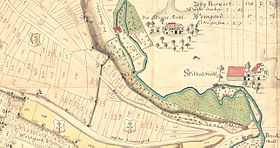Lower Mill (Markgröningen)
The Lower Mill at Markgröningen is under monument protection standing water mill on the Glems , now called small hydropower plant is operated.
history
Its roots go back to a mill “underm Loh” of the miller Trutwinus, which was first mentioned in a document in 1304. He is said to have bequeathed a Malter Grain from his mill to the Katharinenhospital in Esslingen . The mill later appeared under the names "Löhlins-Mühl" (after the field name), "Spreuer-Mühl" and "Hertlinsmühle" (after its owner). It once supplied Talhausen , the desolate hamlet of Eichholtz (later the Katharinenhof domain, now Aichholzhof ) and the Pulverdinger Hof . A foundation stone from 1712, which names two owners: Daniell Mayer and Melchior Pfeffer, refers to a renovation or new building.
The 314 m long canal branched off to the left of the Glems powered four overshot water wheels in 1836 . They were renewed several times during the 19th century. In 1882 the mill had three overshot water wheels, each 2.60 m in diameter and 0.80 m, 1.02 m and 1.85 m wide. At that time it had four grinding courses and one tanning course. In 1888, the then owner Friedrich Wolf replaced the two smaller water wheels with a 2.60 m high and 1.35 m wide water wheel. In 1903 Jakob Breitling replaced all mill wheels with a Francis turbine . This used a gradient of 3.52 m and delivered a raw output of 16.4 hp at 350 l / s water flow. In 1905, the Breitlings mill worked with four grinding stages, one tanning stage, one classifying machine, one tanning machine and two cleaning machines. To support the hydropower, a 12 hp crude oil engine was then put into operation in 1937. The grinding operation was stopped in 1970/71. The last miller was Emil Breitling.
Small hydropower plant
Today the building is used as a residential building. The old mill equipment was sold. In 1985, instead of the old Francis turbine, an Ossberger turbine was installed, which is still used today to generate electricity. The electricity is fed into the EnBW network.
literature
- Markgröningen - people and their city. Comprehensive presentation of the city's recent history in approx. 60 individual articles . Volume 6 of the series Through the City Glasses , ed. v. Working Group on Historical Research, Heritage and Monument Preservation Markgröningen, 477 p., Markgröningen 2000.
- Millers, mills, hydropower . Volume 5 of the series Through the City Glasses , ed. v. Working group for historical research, heritage and monument preservation Markgröningen, 181 p., Markgröningen 1995.
- Thomas Schulz: Mühlenatlas Baden-Württemberg , Vol. 3, The mills in the Ludwigsburg district , Manfred Hennecke, 1999, Remshalden-Buoch, ISBN 3-927981-63-X .
- Information board on Glemsmühlenweg.
Individual evidence
- ↑ Source: Markgröninger Aussfeldkarte from 1752 ( Landesarchiv BW, N 1 No. 85 )
- ↑ Hilde Fendrich: The mill under the Loh , in: Müller, Mühlen, Wasserkraft . Volume 5 of the series "Durch die Stadtbrille", ed. v. Working group for historical research, heritage and monument preservation Markgröningen, Markgröningen 1995, pp. 96–106.
See also
Web links
- Map and information about the Glemsmühlenweg
- List of cultural monuments in Markgröningen (2011) (PDF; 33 kB)
Coordinates: 48 ° 54 '15.7 " N , 9 ° 3' 53.3" E



